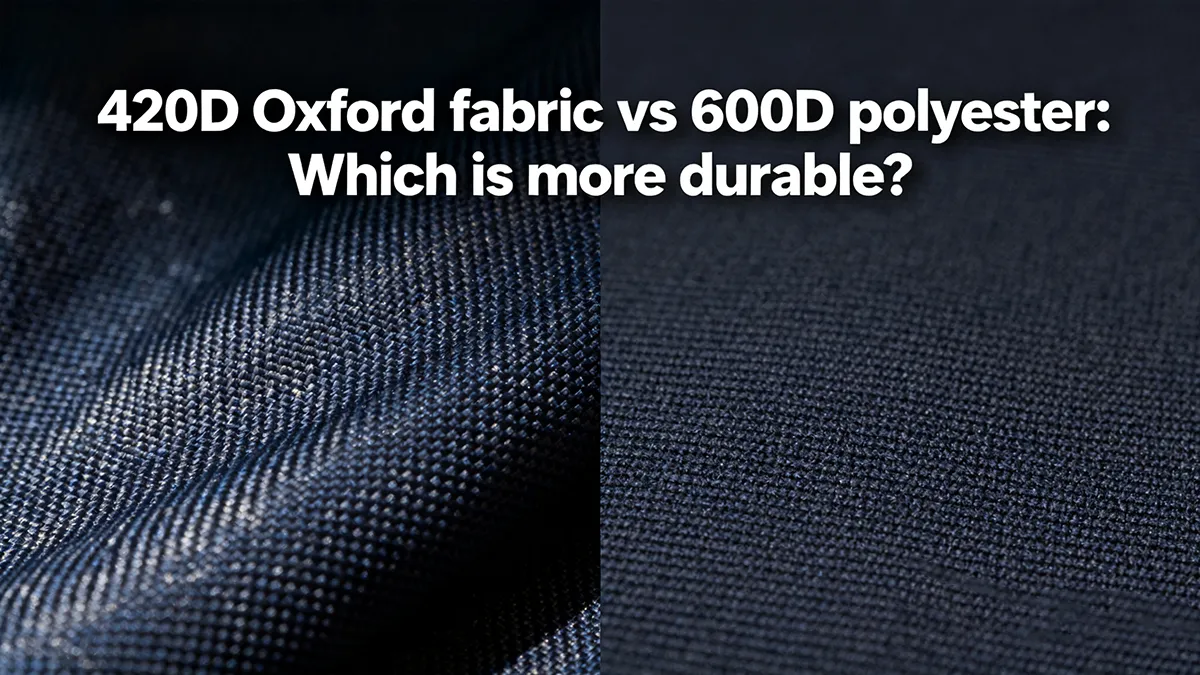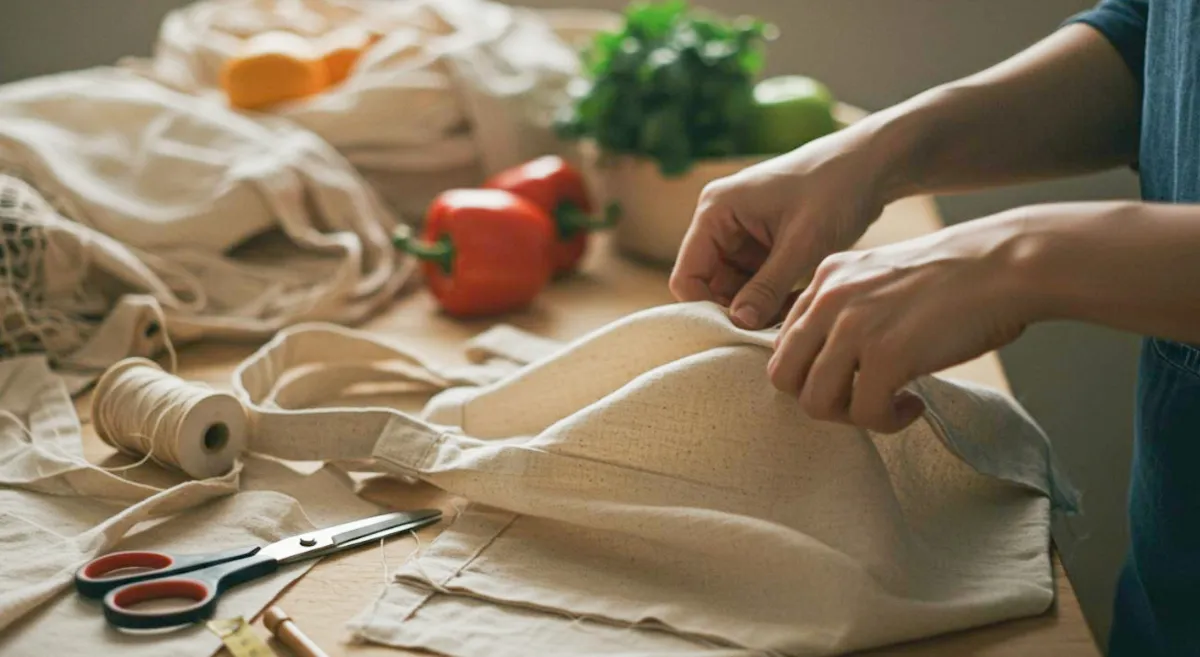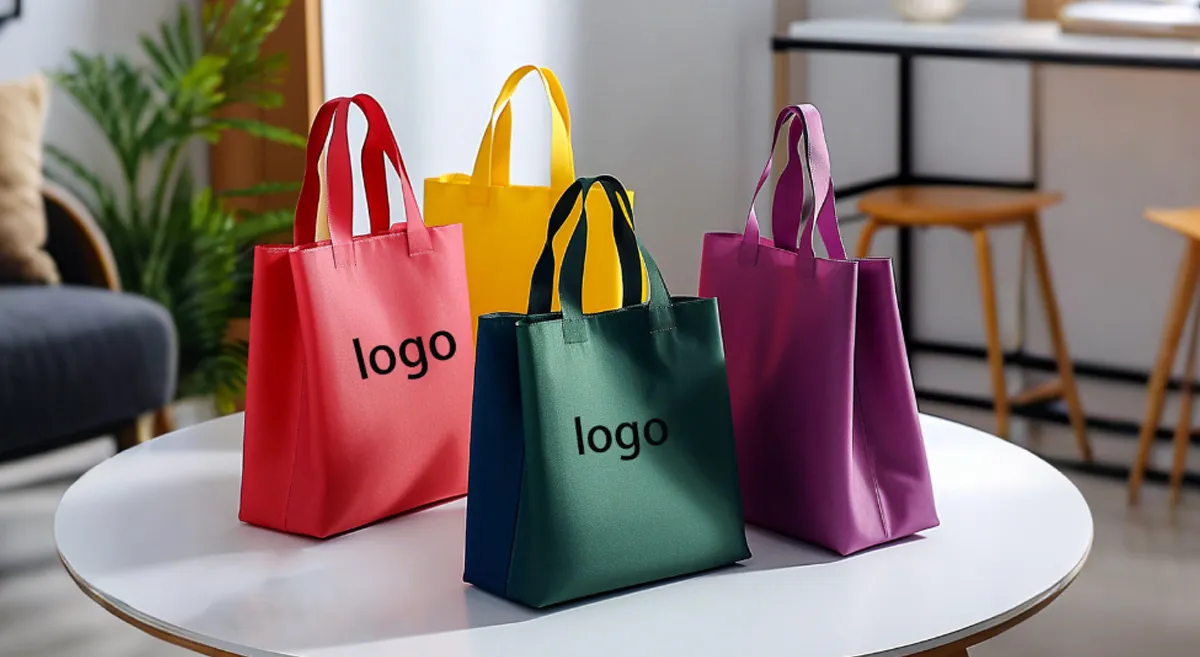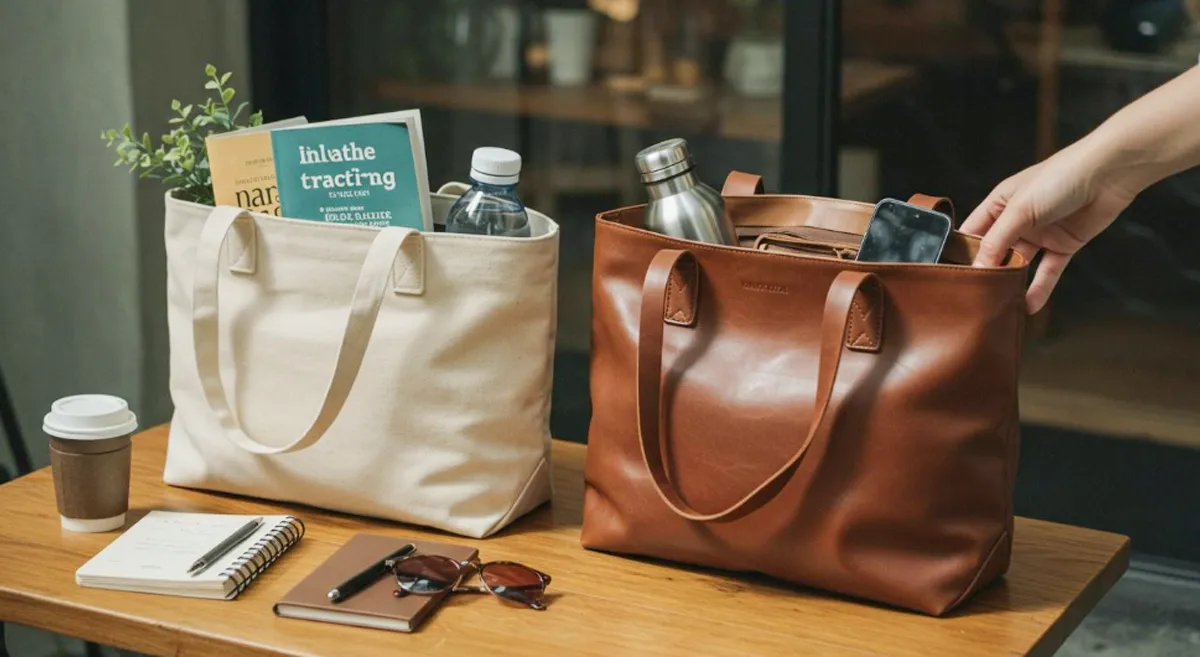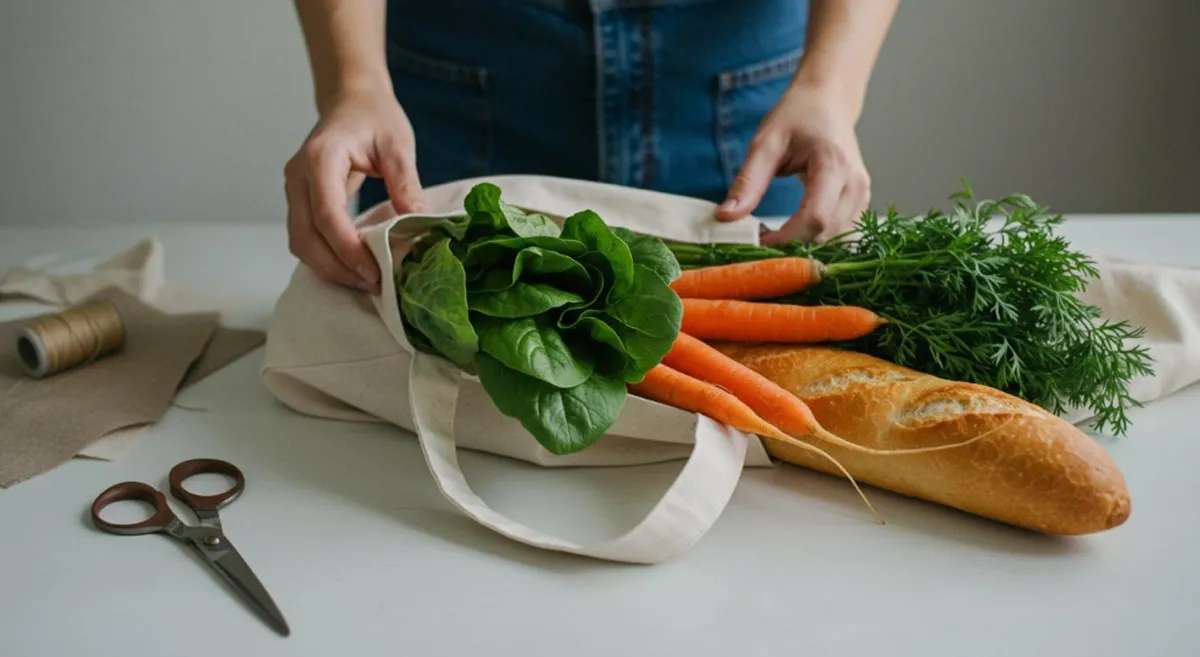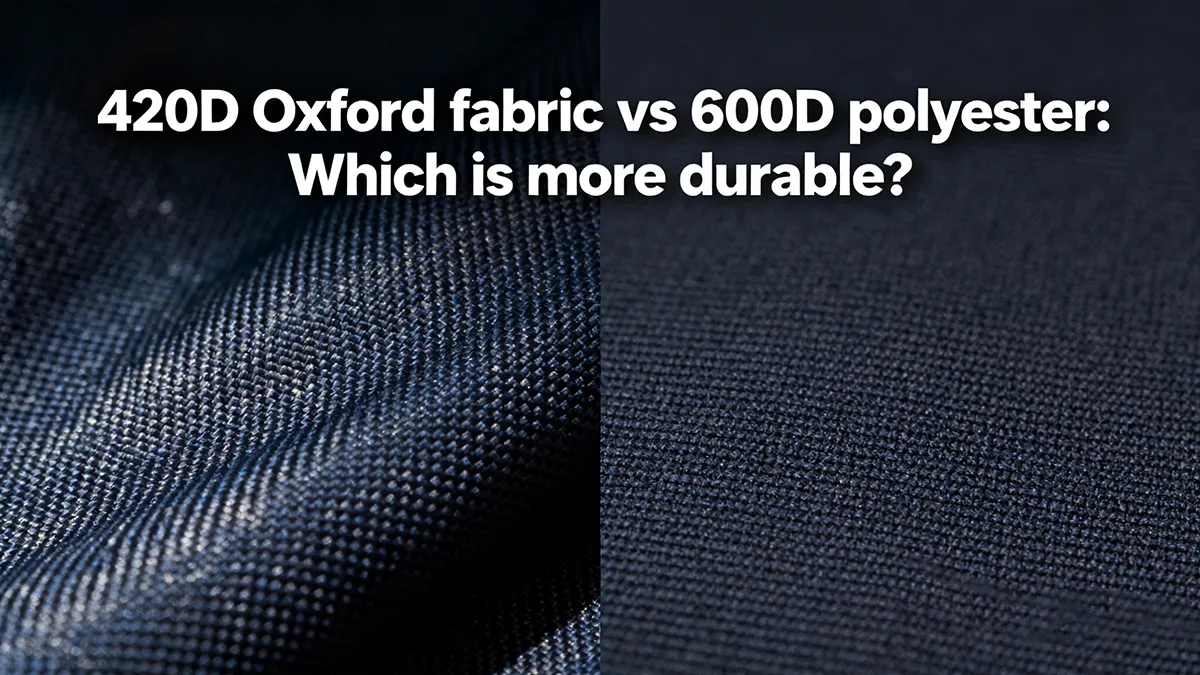
If you compare 420d oxford fabric vs 600d polyester, you will find that 600D polyester usually lasts much longer. You get a thicker, tougher material that stands up to daily wear. This means your bag can handle more weight and rough use. Take a look at this table:
| Fabric Type | Average Lifespan (Months) |
|---|---|
| 420D Oxford | 6–9 |
| 600D Polyester | 18–24 |
You will notice that bags made from 600D polyester last up to three times longer than those made from 420D Oxford. That gives you a big difference in performance and durability.
Key Takeaways
- 600D polyester lasts longer than 420D Oxford. It can last 18 to 24 months. 420D Oxford lasts about 6 to 9 months.
- 600D polyester uses thicker yarn. This gives it more strength and makes it tougher. It is good for heavy-duty bags.
- 420D Oxford is lighter and bends easily. It is great for school bags and promo items.
- 600D polyester does not tear easily. It can handle sharp things and rough use better than 420D Oxford.
- Both fabrics can keep out water if treated. But 600D polyester with PVC coating is best for outside use.
- Pick 420D Oxford if you want something light. Pick 600D polyester if you need strength and long use.
- Think about how you will use your bag. 600D polyester is good for heavy things. 420D Oxford works well for lighter jobs.
- When you pick a fabric, think about cost and how long it lasts. 420D Oxford costs less. 600D polyester lasts longer.
420D Oxford Fabric vs 600D Polyester Comparison
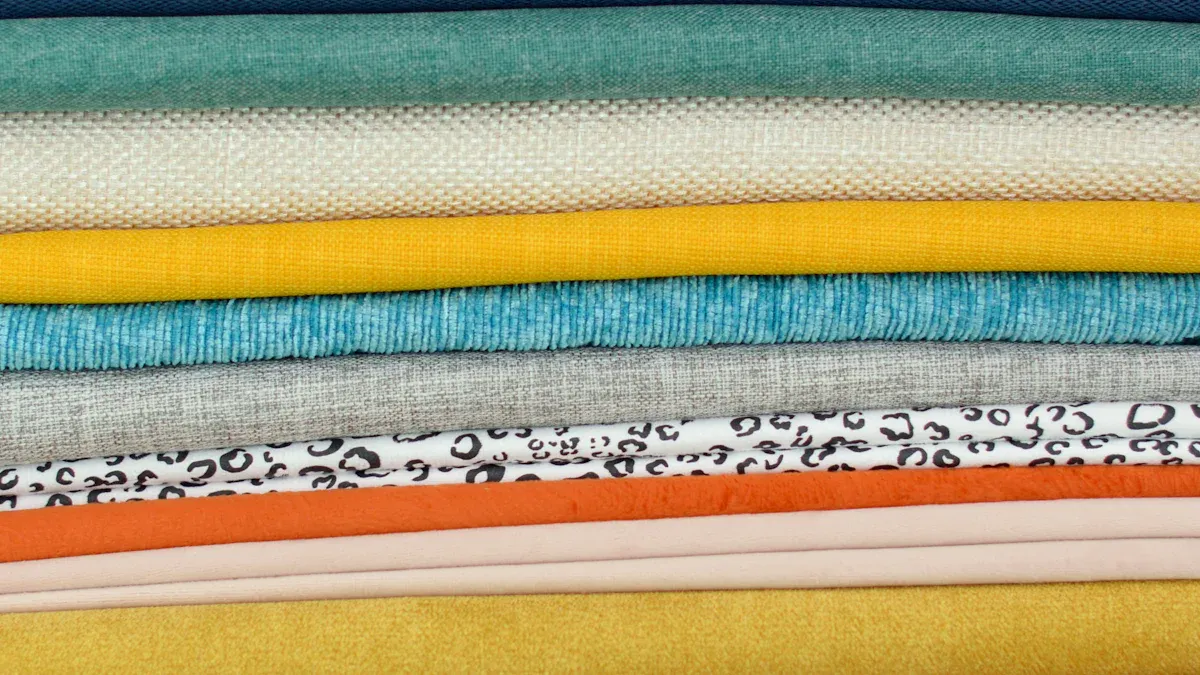
Denier and Thickness
What is Denier?
You might see the word “denier” when you shop for bags. Denier is a way to measure the thickness of the threads in a fabric. A higher denier number means thicker yarn. For example, 420D means the threads are lighter and thinner than 600D. This difference matters a lot for bags.
| Property | 420D Oxford | 600D Oxford |
|---|---|---|
| Yarn Thickness | 420 denier | 600 denier |
| Typical GSM | 180–220 | 220–280 |
| Hand Feel | Softer | Thicker |
| Strength | Lower | Higher |
Impact on Durability
When you compare 420d oxford fabric vs 600d polyester, you notice that 600D is much tougher. Thicker yarns mean the fabric can handle more stress. In lab tests, 420D Oxford fabric failed after about 6,200 abrasion cycles. 600D Oxford lasted over 12,000 cycles before showing wear. That’s almost double the endurance!
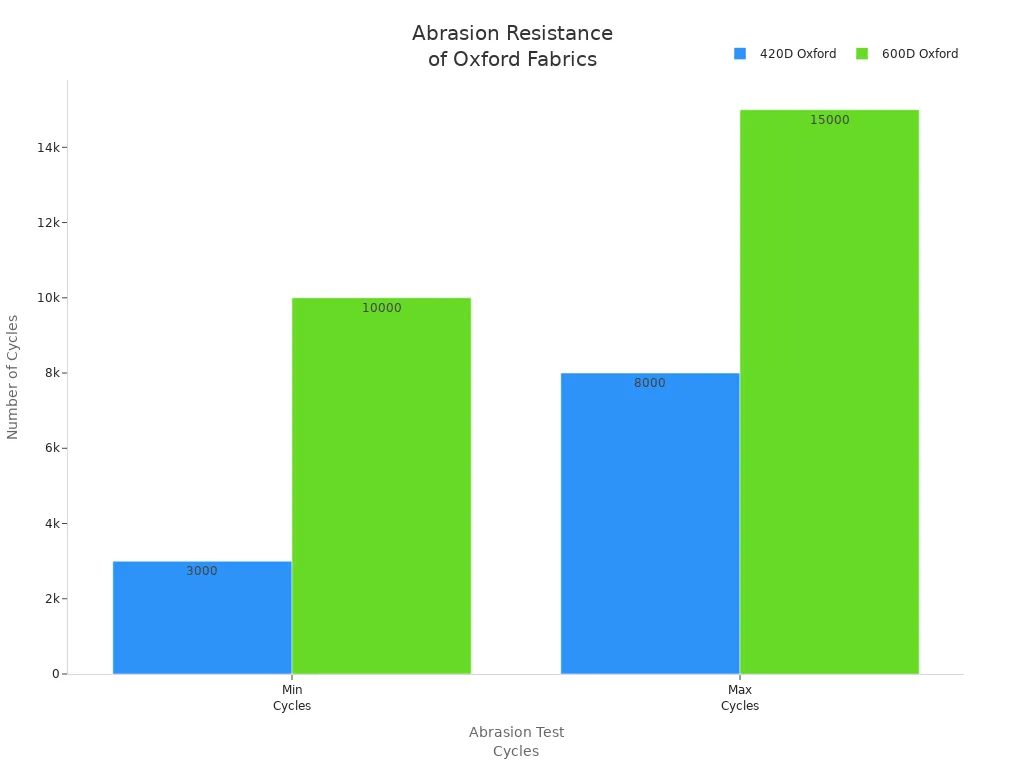
If you want a bag that lasts longer, 600D is the better pick. It stands up to rough use, heavy books, and outdoor adventures.
Material and Weave
Oxford vs Polyester
Oxford fabric uses a basketweave pattern. This weave makes the fabric strong and helps it resist tearing. Polyester, on the other hand, often uses a plain weave. The basketweave in Oxford fabric gives it an edge in durability, especially for bags that get tossed around a lot.
| Fabric Type | Denier | Weave Type | Durability | Abrasion Resistance | Softness |
|---|---|---|---|---|---|
| 420D Oxford | 420D | Basketweave | Good | Good | Moderate |
| 600D Polyester | 600D | Plain/Oxford | Basic | Better (Oxford) | Softer |
Strength Differences
You will find that 600D Oxford fabric is stronger than 420D. The basketweave structure in Oxford cloth makes it tough. It can handle heavy loads, which is important for backpacks and luggage. In real-world use, bags made from 600D Oxford or polyester keep their shape better and last longer. They resist tears and scrapes from daily life.
Tip: If you need a bag for school, travel, or sports, 600D fabric is a smart choice. It gives you more strength and durability.
When you look at 420d oxford fabric vs 600d polyester, you see that 600D is the winner for heavy-duty bags. The thicker yarn and strong weave make a big difference in how long your bag will last.
Durability and Strength
Tear Resistance
Lab Test Results
When you look at tear resistance, you want to know how well a fabric can handle sharp objects or sudden pulls. In lab tests, 600D polyester stands out. It takes more force to rip or tear this fabric compared to 420D Oxford. For example, in a standard tear test, 600D polyester often needs about 30–35 Newtons to tear. 420D Oxford usually tears at around 18–22 Newtons.
| Fabric Type | Average Tear Strength (Newtons) |
|---|---|
| 420D Oxford | 18–22 |
| 600D Polyester | 30–35 |
Note: Higher numbers mean the fabric is harder to tear. This is important if you carry sharp items or heavy gear in your bag.
Real-World Bag Use
You might wonder how these numbers matter in daily life. Imagine you toss your backpack on the ground or stuff it full of books. Bags made from 600D polyester can take more abuse. They resist rips when you snag them on a fence or drag them across rough surfaces. With 420d oxford fabric vs 600d polyester, you will notice that 600D bags rarely get holes from normal use. 420D Oxford bags may show small tears after a few months, especially if you use them for school or travel.
Tensile Strength
Heavy-Duty Applications
Tensile strength tells you how much weight a fabric can hold before it stretches or breaks. For heavy-duty bags, this matters a lot. 600D polyester has a higher tensile strength than 420D Oxford. You can load up a 600D backpack with laptops, books, or even sports gear. The straps and seams stay strong because the fabric does not stretch out or snap.
- 600D polyester is common in:
- Hiking backpacks
- Tool bags
- Luggage for frequent travelers
These bags need to last through rough trips and heavy loads. That is why you see 600D used so often in these products.
Everyday Bags
For everyday bags, you might not need the highest strength. 420D Oxford works well for lighter loads, like tote bags or small backpacks. It feels softer and lighter, which some people like. But if you want a bag that lasts longer and holds more weight, 600D polyester is the better choice.
Tip: When you compare 420d oxford fabric vs 600d polyester, think about how you use your bag. If you carry heavy items or use your bag every day, 600D gives you more strength and peace of mind.
Water Resistance
Coating Types
PU vs PVC
When you look at bags made from 420D Oxford fabric and 600D polyester, you might wonder how they keep water out. Both fabrics get special coatings to help with water resistance. The two most common coatings are polyurethane (PU) and polyvinyl chloride (PVC).
- PU coating creates a waterproof barrier right on the fabric’s surface. You get a lightweight feel, and your bag stays flexible.
- PVC coating gives you even stronger waterproofing. It makes the fabric tough and helps it resist scrapes and chemicals. Bags with PVC coating feel a bit stiffer, but they handle rough conditions better.
You will see these coatings on both 420D Oxford and 600D polyester bags. They help keep your stuff dry when you get caught in the rain or set your bag down on wet ground.
Outdoor Use
If you plan to use your bag outside, coatings matter a lot. PU and PVC treatments make both fabrics suitable for outdoor gear and protective covers. You can take a 600D polyester backpack camping or hiking, and it will keep your gear safe from splashes and light rain. 420D Oxford bags with coatings work well for short trips or as protective covers, but they might not hold up as long in heavy rain.
Tip: For outdoor adventures, look for bags with PVC-coated 600D polyester. You get better waterproofing and durability.
Performance in Bags
Rain Protection
You want your bag to protect your things from rain. Both 420D Oxford and 600D polyester offer some water resistance, but 600D Oxford cloth stands out. It has a certain waterproof function, making it more suitable for bags that need better water resistance. If you walk to school or travel in wet weather, a 600D polyester bag with a good coating keeps your books and electronics dry.
Here’s a quick comparison:
| Fabric Type | Water Resistance | Best Coating | Outdoor Suitability |
|---|---|---|---|
| 420D Oxford | Basic | PU/PVC | Light use |
| 600D Polyester | Strong | PVC | Heavy use |
Suitability for Travel Bags
Travel bags need to handle all kinds of weather. You want a bag that keeps your clothes and gadgets safe, even if you get caught in a downpour. 600D polyester bags with PVC coating work best for travel. They resist water, last longer, and handle rough handling at airports or bus stations. 420D Oxford bags with PU or PVC coating can work for short trips or as lightweight carry-ons, but they may not offer the same level of protection.
- 600D Oxford cloth is stronger than 420D Oxford cloth.
- Both fabrics have some level of water resistance.
- 600D Oxford cloth has a certain waterproof function, making it more suitable for bags that require better water resistance.
You can trust a 600D polyester travel bag to keep your things dry and safe, even when the weather turns bad. If you need a bag for outdoor use or travel, water resistance should be high on your list.
Flexibility and Printability
Flexibility
Packability
When you pick out a bag, you want something easy to pack and carry. 420D Oxford fabric feels lighter and bends more easily. You can fold or roll a bag made from this material without much effort. That makes it great for travel or for stuffing into a locker. If you need a bag that fits into tight spaces, 420D Oxford gives you more options.
600D polyester feels heavier and stiffer. You might notice that bags made from 600D polyester keep their shape better. They don’t fold up as small, but they protect your stuff from bumps and drops. If you want a bag that stands upright and holds its form, 600D polyester works well.
Here’s a quick look at how these fabrics compare:
| Fabric Type | Weight | Flexibility | Durability | Use Case |
|---|---|---|---|---|
| 420D Oxford | Lighter | More flexible | Less sturdy | Lightweight bags, casual apparel |
| 600D Polyester | Heavier | Less flexible | More sturdy | Rugged use, camping equipment |
Tip: If you want a bag that packs down small, go with 420D Oxford. If you need a bag that keeps its shape, choose 600D polyester.
Comfort
You probably care about how a bag feels when you carry it. 420D Oxford fabric feels softer against your skin. The lighter weight makes it comfortable for everyday use. You can sling it over your shoulder and forget it’s there.
600D polyester feels tougher. You might notice it’s a bit rougher, especially if you carry heavy loads. The extra thickness can make straps and handles feel bulkier. If you plan to carry your bag for long periods, comfort matters. Lighter, more flexible fabric like 420D Oxford can make a difference.
Print Quality
Logo Printing
If you want your bag to show off a logo or design, print quality matters. 420D Oxford fabric takes prints well. The smooth surface lets colors pop and lines stay sharp. You can get detailed logos and bright graphics on these bags.
600D polyester also works for printing, but the thicker weave can make fine details look less crisp. Large logos and bold designs show up well, but tiny text or intricate patterns might blur a little. You should think about the look you want before choosing your fabric.
- 420D Oxford: Best for detailed prints and sharp logos.
- 600D Polyester: Good for bold graphics and simple designs.
Color Retention
Nobody wants a bag that fades after a few months. Both 420D Oxford and 600D polyester hold color well, but there are some differences. 600D polyester resists fading from sunlight and washing. Your bag keeps its color longer, even if you use it outdoors.
420D Oxford fabric also keeps colors bright, but it may fade faster if you leave it in the sun or wash it often. If you want a bag that looks new for years, 600D polyester gives you better color retention.
Note: For outdoor bags or school backpacks, 600D polyester helps your colors stay vibrant. For promotional bags or light use, 420D Oxford works just fine.
Cost and Availability
Price
Market Rates
When you shop for bag fabrics, price matters. You want to know what you are paying for and why. 420D Oxford fabric usually costs less than 600D polyester. The difference comes from the thickness and strength of the material. Thicker, tougher fabrics like 600D polyester need more raw material and take longer to make.
Here’s a quick look at the average prices for PU-coated fabrics:
| Fabric Type | Average Price (PU Coated) |
|---|---|
| 420D Oxford | $0.65–$0.90/meter |
| 600D Oxford | $0.85–$1.15/meter |
You can see that 420D Oxford is more budget-friendly. If you want to save money on lightweight bags or promotional items, this fabric works well. For heavy-duty bags, you pay a bit more for 600D polyester, but you get extra durability.
Bulk Orders
When you order fabric in bulk, prices can drop. Suppliers often give discounts if you buy large amounts. You might notice that the price per meter goes down when you order hundreds or thousands of meters. This helps big brands or factories keep costs low. Small orders usually cost more per meter, so it’s something to think about if you are just starting out.
MOQ
Small vs Large Brands
MOQ stands for Minimum Order Quantity. This is the smallest amount of fabric you can buy from a supplier. If you run a small business or want to make a few custom bags, MOQ can be a big deal. Large brands can meet high MOQs easily, but small brands might struggle.
Here’s a table showing typical MOQs for 600D polyester fabrics:
| Fabric Type | Minimum Order Quantity | Price | Delivery Time | Payment Terms |
|---|---|---|---|---|
| 600D Polyester Oxford Fabric | 1000M | 1.2USD/M | 15-20 days | L/C, D/P, T/T |
| Heavy Duty PVC Coated 600D Oxford | 2000M | 0.82USD/M | 15-20 days | L/C, D/P, T/T |
You can see that suppliers often ask for at least 1000 meters. If you only need a small batch, you might have to pay more or find a supplier who works with lower MOQs. Large brands can order thousands of meters and get better deals.
Note: If you are a small brand, check with suppliers about their MOQ before you plan your order.
Supply
Lead Times
Lead time means how long it takes for your fabric to arrive after you place an order. Most suppliers need about 15 to 20 days to deliver 600D polyester fabric. This time includes making the fabric, coating it, and shipping it to you. If you order a special color or print, it might take a bit longer.
You should always ask about lead times before you order. Planning ahead helps you avoid delays, especially if you need your bags ready for a big event or busy season. Large orders may take more time, but most suppliers work hard to meet your deadlines.
Tip: Always factor in lead times when planning your bag production. This helps you stay on schedule and avoid last-minute stress.
Best Uses for Bags
Choosing the right fabric for your bag depends on how you plan to use it. Some bags need to be light and easy to carry. Others must handle heavy loads or tough weather. Let’s look at which fabric works best for each type of bag.
420D Oxford
Lightweight Bags
If you want a bag that feels light and easy to carry, 420D Oxford fabric is a smart choice. You often see this fabric in school bags, daypacks, and lunch bags. It gives you enough strength for daily use but keeps the bag from feeling bulky.
| Bag Type | Reasons for Using 420D Oxford Fabric |
|---|---|
| School Bags | Strong and lightweight, ideal for daily use. |
| Daypacks | Good balance of durability and weight. |
| Lunch Bags | Strong yet not too heavy, suitable for carrying food. |
You can pack your lunch or books without worrying about extra weight. The fabric also folds easily, so you can store these bags in small spaces.
Promotional Bags
420D Oxford fabric is also popular for promotional tote bags. These bags do not need to last for years. They just need to look good and hold up for a few months. The lower cost of 420D Oxford makes it perfect for giveaways or events.
| Application Type | Recommended Fabric | Typical Lifespan |
|---|---|---|
| Promotional Tote Bags | 420D Oxford fabric | 6–12 months |
600D Polyester
Heavy-Duty Bags
When you need a bag that can handle more weight and rough use, 600D polyester stands out. You find this fabric in backpacks for students, sports and gym bags, and laptop bags. It gives you more strength and lasts much longer.
- Everyday backpacks: Great for students and commuters who need a strong, lightweight bag.
- Sports and gym bags: Durable and water-resistant, perfect for workout gear.
- Laptop and office bags: Protects electronics and looks stylish.
| Application Type | Recommended Fabric | Typical Lifespan |
|---|---|---|
| Daily-use Backpacks | 600D polyester | 1.5–3 years |
Outdoor Bags
If you spend time outside, you want a bag that can handle rain, dirt, and rough ground. 600D polyester is a top pick for outdoor and camping gear. It resists water and keeps your things safe in harsh weather.
- Outdoor and camping gear: Reliable for hiking, camping, and other adventures.
Here’s a quick table to help you decide:
| Key Factor | 420D Oxford Fabric | 600D Polyester |
|---|---|---|
| Intended Use | Lightweight uses | Heavy-duty applications |
| Climate Conditions | Less effective in harsh weather | Better for extreme conditions |
| Budget Constraints | More budget-friendly | Higher cost, more durability |
When you compare 420d oxford fabric vs 600d polyester, think about what matters most for your bag. If you want something light and affordable, 420D Oxford works well. If you need strength and long life, 600D polyester is the better choice.
Conclusion
If you want a bag that lasts, 600D Oxford stands out for durability and strength. You get more abrasion resistance and a longer lifespan, while 420D Oxford works best for lightweight and budget-friendly bags. Check out this quick comparison:
| Feature | 420D Oxford | 600D Oxford |
|---|---|---|
| Durability | Moderate | High |
| Cost | Lower | Higher |
| Lifespan | 1–3 years | 2–5 years |
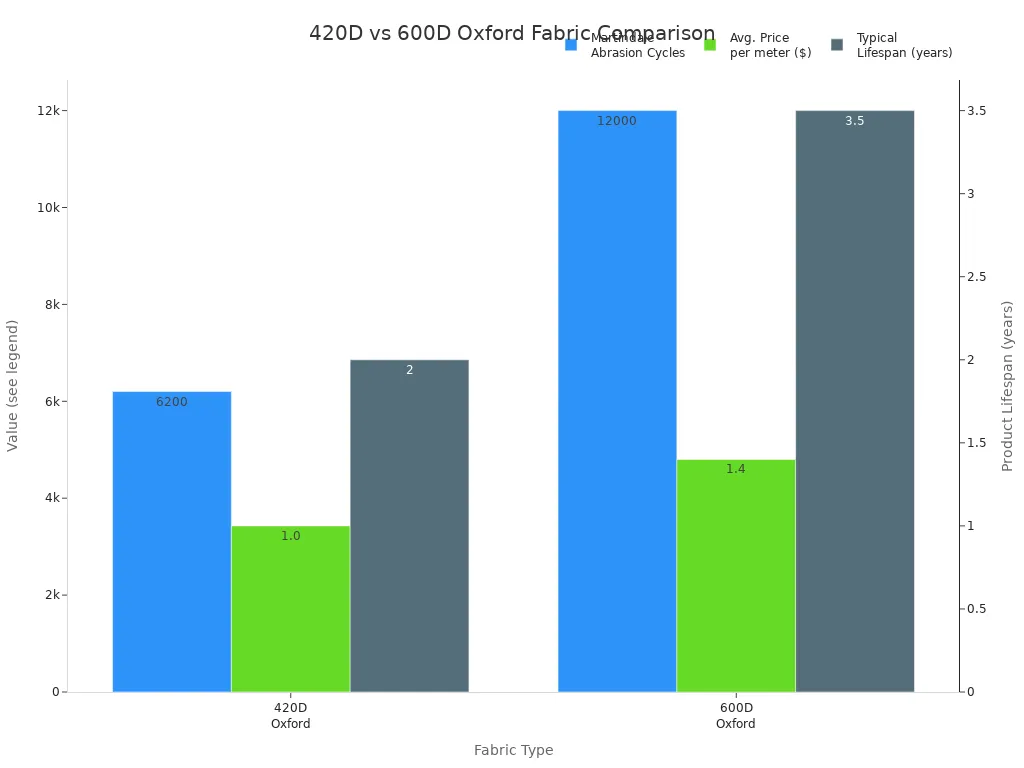
You should pick the fabric that matches your needs. If you want eco-friendly options or custom designs, we offer non-woven, canvas, cotton, and recycled materials. We support OEM/ODM customization for your brand. Let’s help you create the perfect bag!
FAQ
What does “D” mean in 420D or 600D fabric?
“D” stands for denier. Denier measures the thickness of the threads in the fabric. Higher numbers mean thicker threads. So, 600D fabric uses thicker yarn than 420D. You get more strength and durability with a higher denier.
Is 600D polyester always better than 420D Oxford?
You get more durability with 600D polyester, especially for heavy-duty bags. If you want a lightweight bag or a promotional tote, 420D Oxford works well. Your choice depends on how you plan to use the bag and what matters most to you.
Can you wash bags made from 420D Oxford or 600D polyester?
You can wash both fabrics by hand with mild soap and water. Avoid using bleach or harsh chemicals. Air dry your bag to keep its shape and color. Machine washing may damage coatings or weaken the fabric over time.
Do these fabrics resist water without a coating?
You get some water resistance from the weave, but not enough for heavy rain. Most bags use PU or PVC coatings to improve water resistance. If you need protection from rain, look for bags with coated fabric.
Which fabric is better for printing logos or designs?
You get sharper prints on 420D Oxford because of its smoother surface. 600D polyester works well for bold graphics and simple logos. If you want detailed designs, 420D Oxford is your best bet.
Are 600D polyester bags heavier than 420D Oxford bags?
Yes, 600D polyester bags feel heavier and sturdier. You get more protection for your items, but the bag may not fold as easily. If you want a lightweight, packable bag, 420D Oxford is a better choice.
How long do bags made from these fabrics usually last?
You can expect 420D Oxford bags to last 6–12 months with regular use. 600D polyester bags often last 1.5–3 years or more. Lifespan depends on how you use and care for your bag.
Can you use these fabrics for outdoor gear?
You can use both fabrics for outdoor gear, but 600D polyester works better for rough conditions. It resists tears, water, and abrasion. 420D Oxford suits light outdoor use, like picnic bags or covers.

